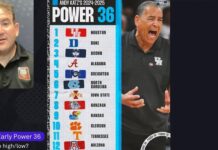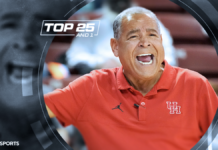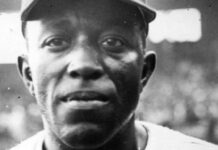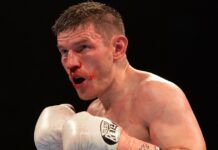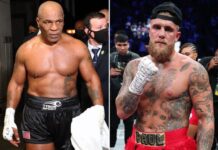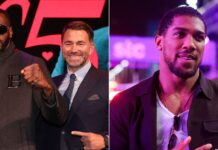SANTA CLARA, Calif. — San Francisco 49ers quarterback Jimmy Garoppolo is no stranger to the shifting dynamics of an NFL quarterback room.
In 2014, Garoppolo was the New England Patriots‘ hand-picked successor to Tom Brady. For nearly four seasons, Garoppolo took notes on how Brady went about his business and worked to pick up anything he could that might someday help him take over.
Seven years later, Garoppolo finds himself on the other side of the equation. He’s the 49ers’ starter, but it’s unclear how long he can hold off No. 3 overall pick Trey Lance.
In the opening weeks of training camp, Garoppolo’s primary approach to dealing with Lance’s presence is to view it as something that doesn’t need dealing with, a similar tack Brady took upon Garoppolo’s arrival.
“Honestly, I try not to put too much thought into that,” Garoppolo said. “I think that stuff just comes naturally … when you let it happen organically, and that’s what kind of we’ve done, I think that’s when it’s at its most natural and you can really build a normal relationship between two people. … I don’t want to draw a line anywhere or anything like that, but anything he needs, I’m willing to help him.”
To be sure, it’s a unique situation. The 49ers are the only team in NFL history to take a quarterback higher than No. 25 one full season removed from a Super Bowl appearance.
How Garoppolo, Lance and the 49ers handle it will go a long way in determining how the 2021 season plays out. As the veteran in the situation, Garoppolo’s role is especially important. If he can hit all the right notes (combined with much-improved injury luck), San Francisco has a chance to leap back into playoff and possibly Super Bowl contention.
Garoppolo appears to be doing that so far, something that has not surprised Hall of Fame quarterback Steve Young.
“That’s part of the problem is how well he’s handling it,” Young said. “That makes it even more complex. Management has spoken. The locker room has its own opinions. Jimmy is going to create this to be a more complex situation.”
Young is no stranger to complex quarterback scenarios. Neither is Joe Theismann, Doug Flutie and Tony Romo, all of whom look back on their time in Garoppolo’s shoes with important lessons on how to handle it.
Be ‘a windshield guy’
In 1982, nine-year pro Theismann led Washington to a victory in Super Bowl XVII against the Miami Dolphins. For an encore, he led Washington back to the big game with an MVP award but came up short against the Raiders.
That didn’t stop Washington from using a third-round pick on quarterback Jay Schroeder in the 1984 NFL draft. At that point, Theismann had already overcome challenges from other quarterbacks such as Tom Flick (fourth round, 1981).
The key to Theismann’s success was simple, and it’s one he’s more than willing to share with Garoppolo.
“Jimmy has just got to play football,” Theismann said. “I never looked over my shoulder. I’ve never been a rearview mirror kind of guy. I’m a windshield guy. I like to see what’s out in front of me and I like to work on what I’m doing to get better.”
For Garoppolo, that means building on the things he did well during an offseason program coach Kyle Shanahan called the best he’s seen from Garoppolo in their four years together.
Garoppolo spent his 40 days away from the facility focused on his playbook with the knowledge Shanahan and offensive coordinator Mike McDaniel would have new wrinkles for him to learn. From a physical standpoint, Garoppolo emphasized strengthening the ankle that cost him 10 games in 2020.
“No. 1 is he has got to stay healthy,” Theismann said. “That’s the biggest thing. It’s the only way you can get better. I can read a book on tennis, but I can’t play Rafael Nadal, so you have to be out there doing it.”
Teaching by example
Flutie played 92 NFL games during a career that saw him bounce between Canada and the United States. By the time he wasn’t just competing for a roster spot but fighting for a starting job, he’d already been through many quarterback competitions and had a good handle on the ins and outs.
Most notably, Flutie battled Rob Johnson for the Bills’ starting job after both landed in Buffalo in 1998. Before that, Flutie had been a three-time MVP in the CFL and never viewed any of the quarterbacks on his teams as a threat. In Canada, Flutie openly offered advice and pointers to his fellow quarterbacks.
The situation in Buffalo was far more intense. When it all came to a head after the 2000 season, Johnson was the starter and Flutie shipped to the Chargers.
It was a long, head-scratching affair, but despite the constant speculation and headlines it generated, Flutie found the best way to approach it was to stay focused on himself. That was especially important during training camp when the competition was at its peak. Once the season began he could let his guard down.
“Once we got into the season, it’s a team effort,” Flutie said. “I know there was a lot made out of that, but we were both there supporting each other throughout the season.”
That doesn’t mean Flutie would advise against answering questions from another quarterback during training camp. In fact, Flutie points out that having constant dialogue with the other quarterbacks is a good way to stay sharp on the finer details of playing the position.
Flutie emphasizes the importance of teaching by doing. In Garoppolo’s case, it isn’t so much about answering X’s and O’s questions as it is setting an example for Lance by how he goes about his day. What time is he showing up? How much time is he putting into film study? How close is he paying attention to the reps the other quarterbacks get in practice?
According to Flutie, all of that served the dual purpose of helping out a teammate while making himself better as a player.
“More the work ethic is what you teach,” Flutie said. “What it takes to be an NFL quarterback and the hours you have to put in and the film study and the camaraderie of the offensive line and the things of that nature … little things that all come into the big picture.”
‘Constructive competitiveness’
A big-picture mindset and a tone-setting work ethic undoubtedly will help Garoppolo while improving the team. But nothing means more than steering into the skid.
When Shanahan called Garoppolo to tell him about the trade up to No. 3, one of Garoppolo’s first questions was whether he’d get the chance to compete. Told that he would, Garoppolo immediately began preparing.
That has carried over into training camp and rubbed off on the rest of the quarterbacks.
“It’s like constructive competitiveness,” McDaniel said. “They’re trying to help each other, but they’re demanding and being accountable to themselves to try to organically raise their game.”
Garoppolo has made himself available to Lance when needed while remaining focused on the task at hand. He said he isn’t finding any additional motivation from Lance’s presence, though multiple teammates have noted a “fire” in Garoppolo previously unseen.
“I try to do that myself,” Garoppolo said. “If you don’t push yourself, then you’ve got no chance in this game. If you rely on outside forces to motivate you, it’s going to be tough. At the end of the day, I’m as motivated as it gets.”
At some point, Lance will overtake Garoppolo as the starter, but so far the Niners don’t seem to be in a hurry to make that change.
A continued professional approach will help Garoppolo. Ultimately, the thing that will determine how long he remains the starter will be how he fares when it matters most.
“In the NFL, there’s always competition,” Romo said. “Your job as a player is just to keep getting better and improve. Figure out what you weren’t as good at that you needed to be the year before. As the quarterback you’re trying to figure out your weaknesses and make them strengths. And I feel like they’re always going to throw competition at you. Obviously for Jimmy his job is he goes and plays good football, he’s fine. If he doesn’t play good football, well, nobody’s fine.”























